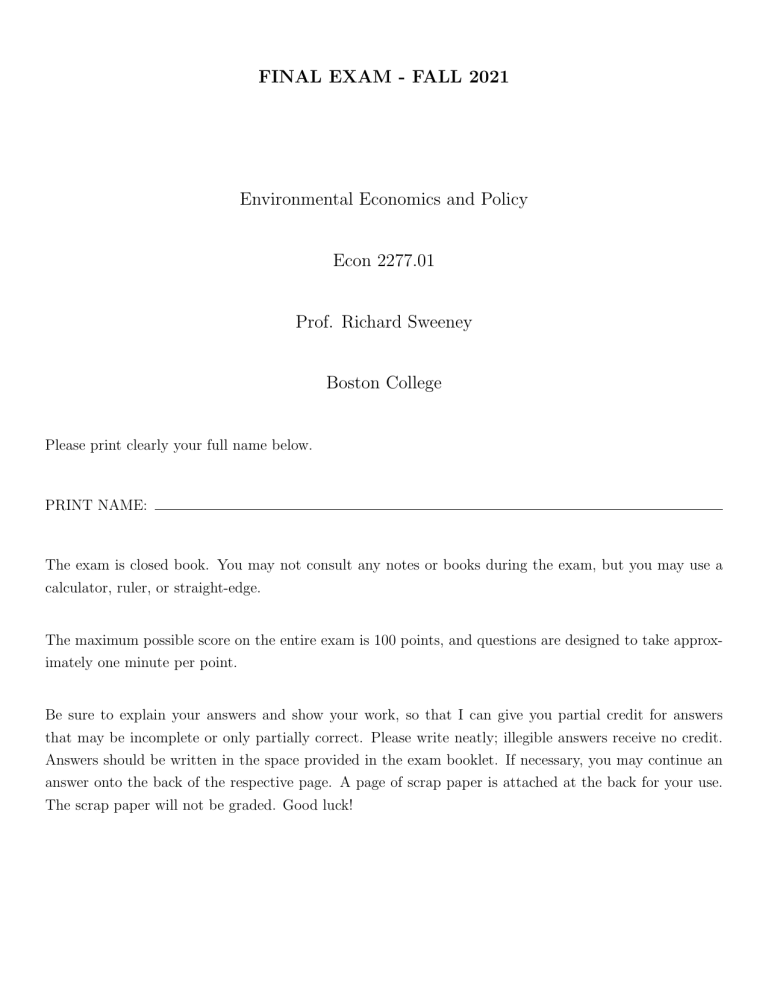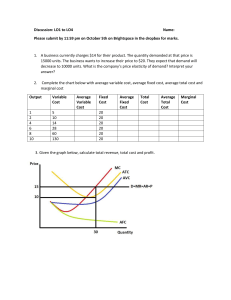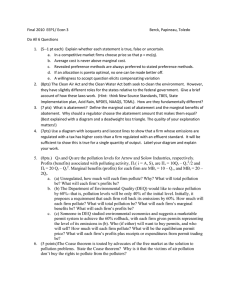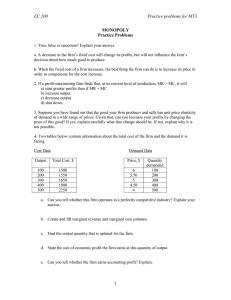
FINAL EXAM - FALL 2021 Environmental Economics and Policy Econ 2277.01 Prof. Richard Sweeney Boston College Please print clearly your full name below. PRINT NAME: The exam is closed book. You may not consult any notes or books during the exam, but you may use a calculator, ruler, or straight-edge. The maximum possible score on the entire exam is 100 points, and questions are designed to take approximately one minute per point. Be sure to explain your answers and show your work, so that I can give you partial credit for answers that may be incomplete or only partially correct. Please write neatly; illegible answers receive no credit. Answers should be written in the space provided in the exam booklet. If necessary, you may continue an answer onto the back of the respective page. A page of scrap paper is attached at the back for your use. The scrap paper will not be graded. Good luck! 1 Multiple Choice [3 points each] 1.1. Benefit cost analysis usually makes several important assumptions. Identify the assumption it does not make from the list below A. all relevant benefits and costs have been included B. marginal benefits from the proposed policy intervention will be equal to the marginal costs C. improvements can be judged as taking place as long as there is the potential for gainers to compensate losers from a policy D. benefits and costs that are realized over time can be represented in present value terms 1.2. In the last lecture, we discussed the Regional Greenhouse Gas Initiative (RGGI), a cap-and-trade program which limits carbon dioxide emissions from electric power plants in 10 northeast states. Econometric studies have demonstrated that RGGI has been effective at reducing carbon dioxide in these states, however it has also increased electricity prices. Currently all RGGI permits are auctioned. A governor proposes that, instead of auctioning permits next year, RGGI should give the permits away for free to electric power plants. If this were to happen, A. Electricity prices would be unchanged, but firm profits would go up B. Electricity prices would go down, but firm profits would be unchanged C. Electricity prices would go down and firm profits would go down D. Neither electricity prices nor firm profits would change 1.3. Consider the simple model of nonrenewable resource extraction we studied in class. The Hotelling Rule states that, along the optimal extraction path, A. the resource price should rise at the discount rate B. resource consumption should rise at the discount rate C. the marginal extraction cost should rise at the discount rate D. the marginal user cost should rise at the discount rate E. net benefits should rise at the discount rate 1.4. One of the following statements is false. Identify the incorrect statement: A. the market demand for a private good is the horizontal sum of all individuals’ demands B. the market demand for a public good is the vertical sum of all individuals’ demands C. nonrival goods will generally be efficiently provided by the market as long as they are also nonexcludable D. rival goods will generally be efficiently managed as long as they are also excludable 1.5. In class we discussed many advantages of market based or incentive based instruments (MBIs) for environmental protection, relative to command and control regulation. In what circumstances might MBIs NOT be preferable to command and control? A. firms have very different abatement costs B. the benefits of reducing pollution are uncertain C. the government needs to raise money for other (unrelated) social objectives D. none of the above (MBIs preferred in each of these cases) 1.6. Pollutant X is hazardous to human health. Epidemiologists have studied X and concluded that the marginal benefits to society of reducing X by one unit are $500 at ALL levels of X (ie MB is constant and equal to $500). Given this, a $500 tax on X pollution is A. Efficient BUT NOT cost-effective B. Cost-effective BUT NOT efficient C. Efficient AND cost-effective D. NEITHER cost effective nor efficient E. Not enough information 1.7. Ramsey (1928) proposed a formula for choosing the discount rate when evaluating a policy that spans many years. Which of the following is NOT a parameter in this formula? A. The growth rate in consumption B. The extent to which people value marginal consumption less as they become richer C. The rate at which we value people in the future less simply because they are not alive today D. The degree of uncertainty about future benefits 1.8. A nation-wide carbon tax is politically impossible in the US at the moment. However, “green” subsidies, which reduce the (private) marginal cost of renewable energy are actually quite popular. Compared to a Pigovian tax on carbon emissions, a subsidy on renewable energy A. Results in more energy consumption. B. Generates larger societal net benefits. C. Increases the energy prices consumers face. D. All of the above 2 Short Answers 2.1. (6 points) Characterizing climate change Pollutants can be categorized along two important dimensions: a temporal dimension and a spatial one. A) Describe greenhouse gases (like carbon dioxide) along these two dimensions. [1 sentence each] B) For each dimension, briefly explain why this aspect of greenhouse gasses makes combatting climate change particularly challenging, from a policy perspective. [2-3 sentences each] 2.2. (5 points) Should BC go green? Massachusetts participates in the Regional Greenhouse Gas Initiative, a 10 state cap-and-trade program limiting CO2 emissions from the electric power sector. However, some Boston residents want to do more to combat climate change. Catering to this demand, the electric utility company serving Boston has begun offering a “green” power option. Under this plan, consumers pay more each month, and the utility ensures that 100% of the electricity procured on their behalf will come from solar or wind energy (as opposed to coal or natural gas). After the Pope’s encyclical, BC wants to make sure its doing everything it can to combat climate change. If you were advising Father Leahy, would you advocate paying more each month for this plan? Why or why not? 3 Sharing a river There is a paper mill located along a river, and a firm decides to locate a fishery downstream on the same river. The fishery can locate either near to or far from the paper mill. The nearby downstream location is better in the absence of pollution, but pollution lowers profits for the fishery. The mill currently earns a profit of $500, and it can set up an effluent treatment plant to eliminate pollution at a cost of $200. Profits (ie net benefits) for each firm under each of the four scenarios are given in the following table: Scenario Pollution Equipment Fishery Location Mill Profits Fishery Profits A No Far 500 200 B No Near 500 100 C Yes Far 300 300 D Yes Near 300 500 3.1. (4 points) Which scenario is the efficient outcome? A. Scenario A B. Scenario B C. Scenario C D. Scenario D 3.2. (4 points) Assume the fishery is given the right to a clean river and cooperation between the firms is infeasible. Which of the four potential scenarios will occur? A. Scenario A B. Scenario B C. Scenario C D. Scenario D 3.3. (4 points) What if the paper mill is given the right to pollute the river and cooperation between the firms is infeasible. Which of the four potential scenarios will occur? A. Scenario A B. Scenario B C. Scenario C D. Scenario D 3.4. (6 points) Now assume that the paper mill has the right to pollute, but cooperation between the two firms is feasible. What does the Coase theorem predict will happen? Your answer must contain two components: 1. Describe which outcome will obtain and clearly describe the terms of any cooperation (ie any side payments). 2. List the key assumptions underlying this prediction. 4 Prices vs. quantities In a seminal paper, Martin Weitzman derived a simple rule for when policymakers should prefer a tax vs cap-and-trade in the face of uncertainty. 4.1. (8 points) Draw two graphs illustrating this result. Assume that marginal benefits are known (ie certain), but marginal costs end up being LOWER than expected. Draw one graph where a quantity instrument performs better, and one graph where a price instrument performs better. In words briefly describe what “performs better” means by referring to your graphs. CLEARLY LABEL ALL AXES AND FUNCTIONS. 4.2. (5 points) Weitzman also showed that if only benefits are uncertain, the two instruments perform equally well. Explain the intuition for this result. If the cost curve is known with certainty, but marginal benefits are uncertain, why doesn’t it matter whether policymakers use taxes or cap-and-trade? 5 Hot spots In the figure below, MB1 is the marginal benefit that town 1 gets from abatement; MC2 is the marginal benefit for town 2. MCA is the marginal cost of abatement for source A, and MCB is the marginal cost of abatement for source B. This is a non-uniformly mixing pollutant. 5.1. (3 points) If source A is located in town 1, what is the efficient level of abatement for source A? Label this qA∗ . 5.2. (3 points) If source A is located in town 1, what level of pollution tax will achieve the efficient level of pollution in town 1? Label this T ∗ 5.3. (4 points) Assume that source B is located in town 2. If a tax of T ∗ is implemented in both towns, will that be economically efficient? Justify your answer. 5.4. (4 points) Continue to assume that source A is in town 1 and source B is in town 2. Would a uniform pollution standard, requiring qA∗ emission reductions in both towns be economically efficient? Again, justify your answer. 6 Capping refinery emissions A city has two oil refineries, A and B. Both plants have 100 units of baseline pollution. However it costs much more to reduce pollution at refinery B than at refinery A. The city wants to cut refinery emissions in half, which requires that emissions reductions at firm A (labeled qA) plus emission reductions at firm B (labeled qB) equal 100. Please answer the following questions by referencing the areas labeled in the graphs. 6.1. (5 points) In the interest of fairness, the city council proposes that each firm reduces its emissions by 50 units. What will the total cost of this policy be? A. ijkmn B. imn C. imnfg D. dijmnf E. hikmnf 6.2. (4 points) An economist suggests using cap-and-trade instead. He tells the council to create 100 pollution permits to achieve the city’s environmental target. Refinery A has political connections and successfully lobbies to obtain all 100 permits for free. After this, Refinery A turns around and then sells permits to refinery B at price W. How much does this cap-and-trade program (privately) cost each firm? A. cost to A: hkim; cost to B: nf B. cost to A: im; cost to B: n C. cost to A: im - hk; cost to B: f - n D. cost to A: -hk; cost to B: hkimn E. cost to A: imnf; cost to B: -n 6.3. (4 points) It turns out that the marginal benefits of this pollutant are constant, and also equal to W. With this information, what are the net social benefits of this cap-and-trade program? A. djg B. dhjkgf C. hikmnf D. jkfg E. hkf 6.4. (4 points) A consulting company offers refinery B a new “green” technology which will help it clean up its act. If adopted, this new technology will give refinery B the same abatement marginal cost curve as refinery A (in the picture below, the new curve is mc*(qB)). What are the social gains from this new technology? Put another way, how much larger are the (social) net benefits of this cap-and-trade program when refinery B has cost curve mc*(qB), compared to when it has cost curve mc(qB)? A. xyzs B. zs C. xyzsf D. djxyzs E. djg 6.5. (4 points) Is there too much innovation under this cap and trade program? Let X be your answer to the previous problem – ie X is the increase in net benefits gained by society if refinery B goes green. If it cares only about maximizing its own profits (or minimizing its own private policy costs), is firm B willing to pay more or less than X to get this new technology? Answer this question by referring to the graph, and describing how much firm B would be willing to pay to get this technology [Hint: compare firm B’s private compliance costs from question 2 with its costs under mc*(qB) ]. Briefly (a few sentences) comment on the implications of this example for cap-and-trade programs. Under cap and trade, do polluters like B have too much of an incentive to improve technology or too little (relative to the social optimum)? Why is that? [SCRATCH] [SCRATCH] [SCRATCH] [SCRATCH]




